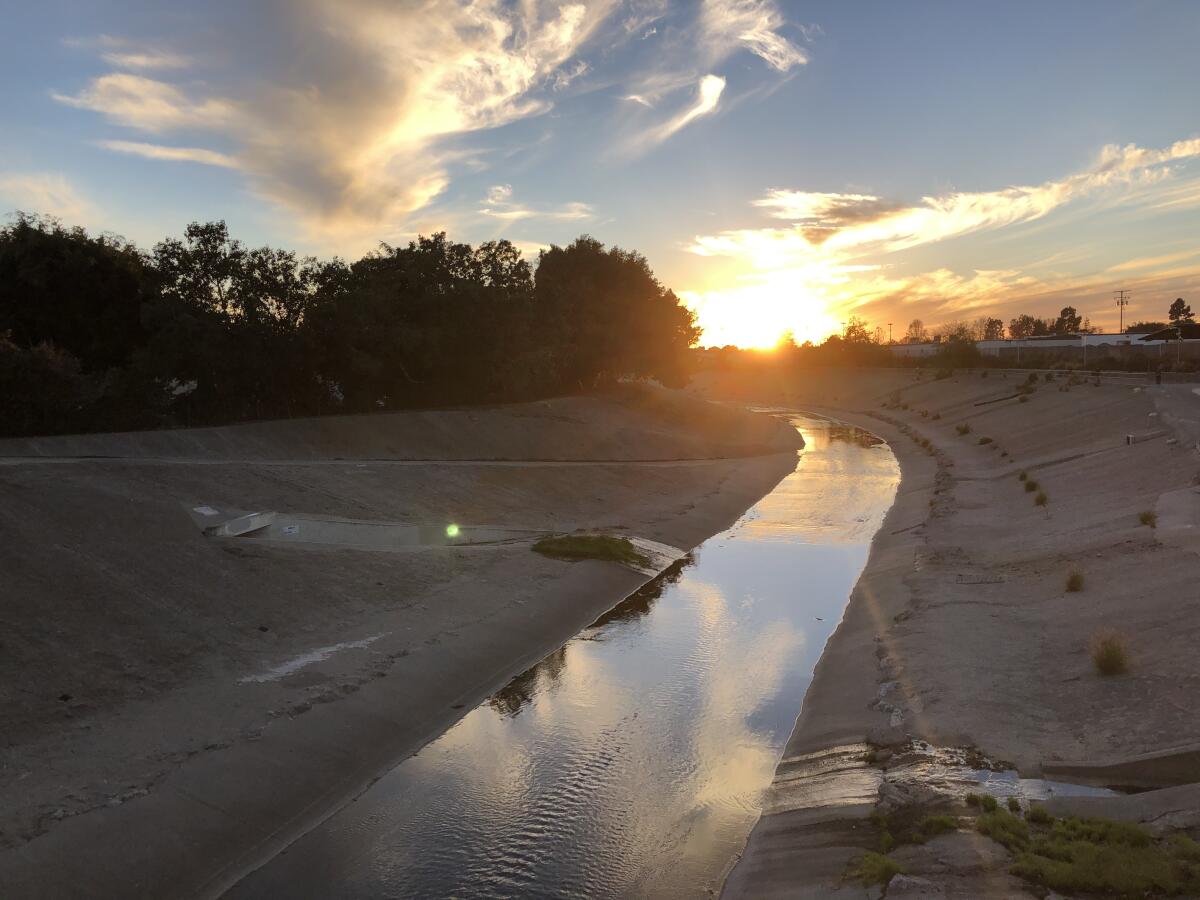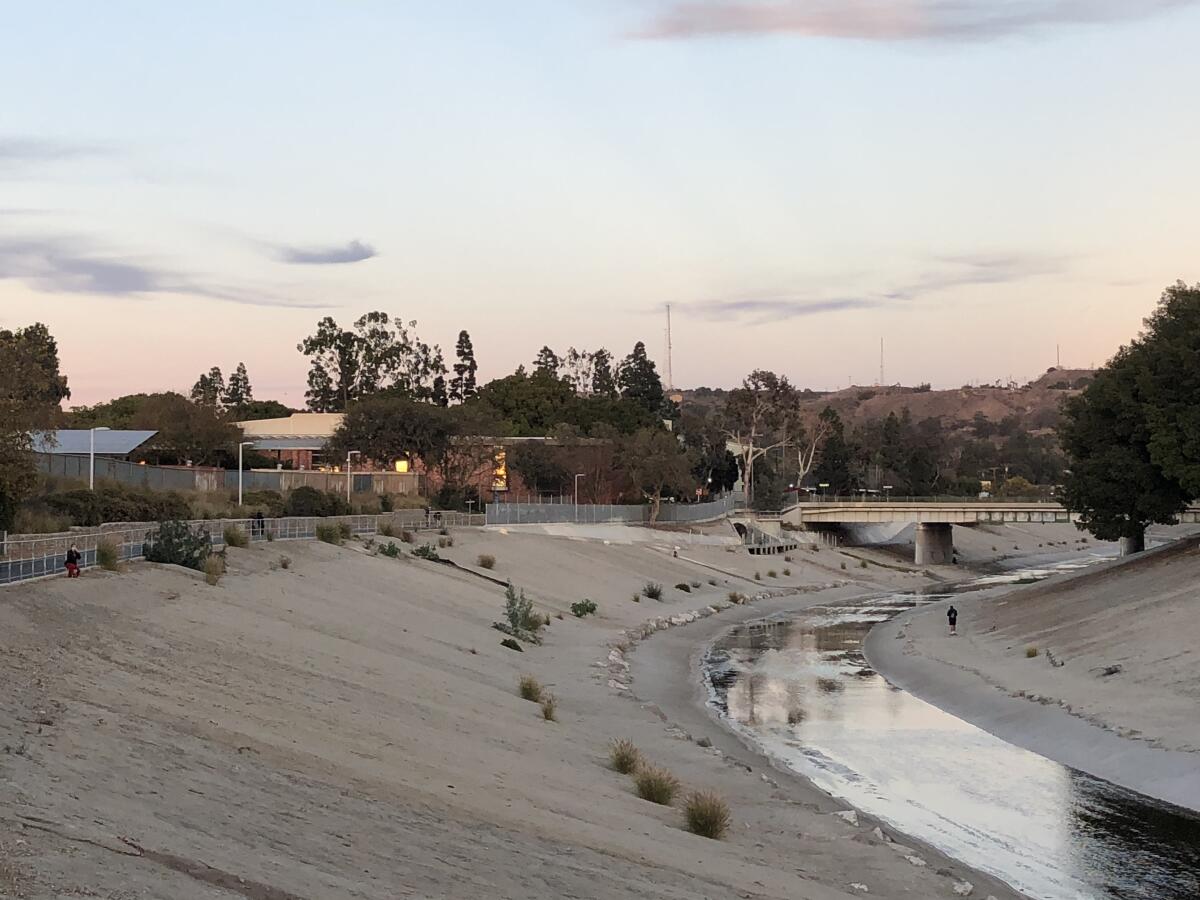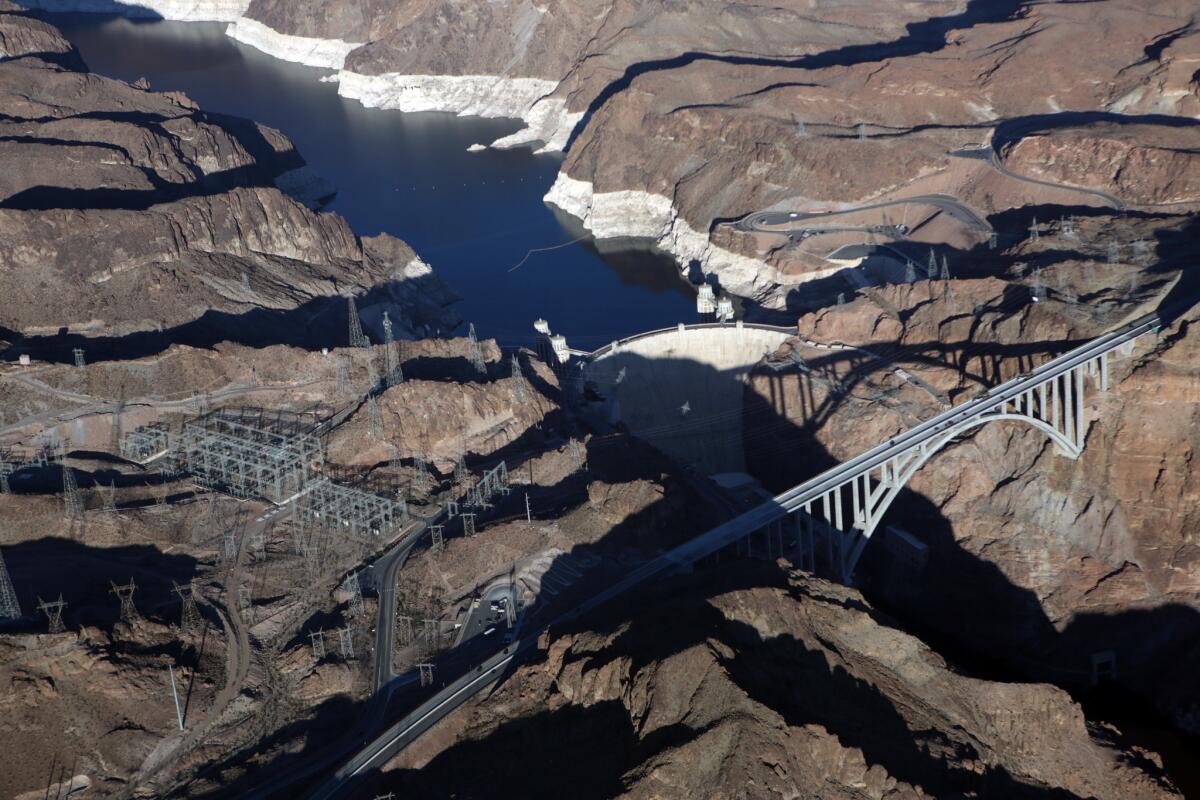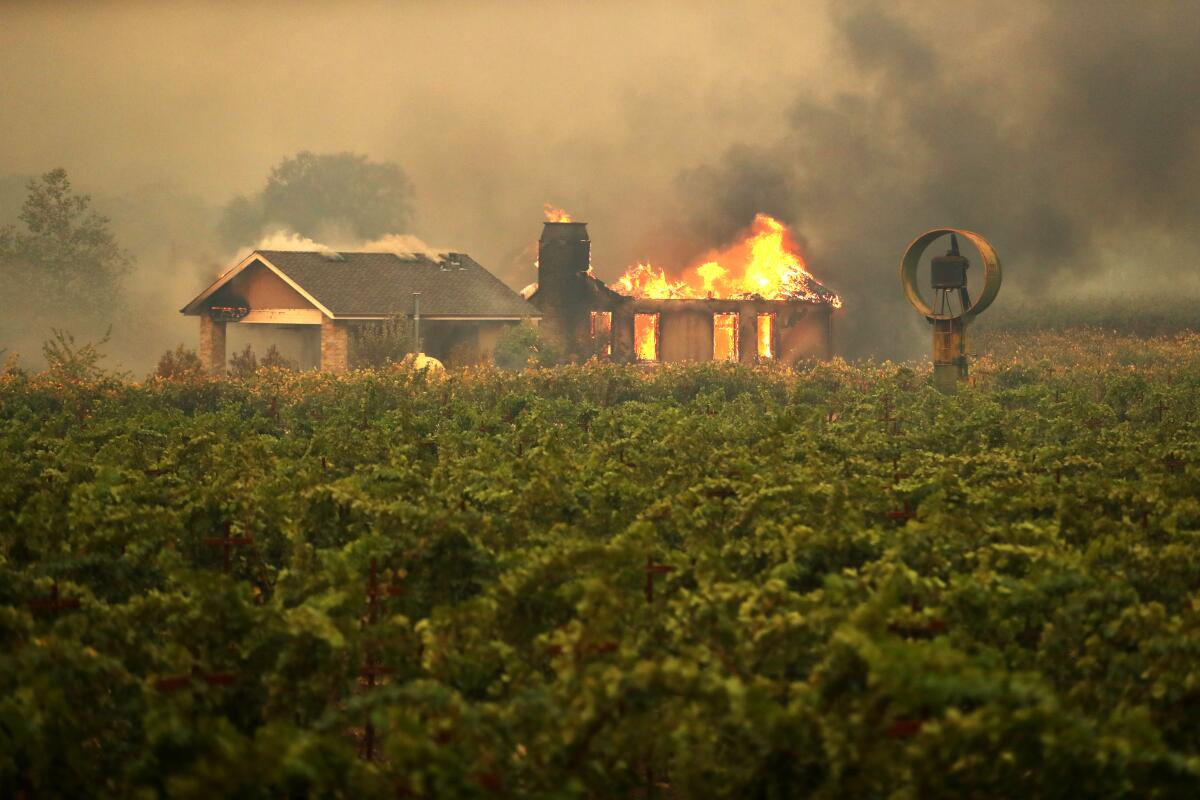How I got beyond the concrete and learned to love my watershed

- Share via
This is the April 8, 2021, edition of Boiling Point, a weekly newsletter about climate change and the environment in California and the American West. Sign up here to get it in your inbox.
A year ago, when stay-at-home orders were a newly disorienting fact of life, I started taking long walks through my neighborhood on L.A.’s Westside. Wandering south from Palms into Culver City, I realized I live near a huge concrete channel — a creek, trapped in place — with a bike path along the water, and a view of oil pumpjacks rising and falling atop the Baldwin Hills.
There were beautiful murals, too, showing a healthy, thriving waterway. They were hashtagged #KnowYourWatershed. And the more I admired them, the more I realized that I did not, in fact, know my watershed, despite growing up not far from here.
Fortunately, one cool part of being a journalist is that when I see something interesting, I can often find a good reason to write about it and learn more. And little did I know, as the pandemic got underway, that I had already begun working on a story with connections to this waterway, Ballona Creek.
That story published yesterday, and you can read it here. It’s about a natural gas storage field thousands of feet below the Ballona Wetlands, where the creek empties into the Pacific Ocean. If the Southern California Gas Co. facility were to suffer a failure similar to the infamous methane blowout at Aliso Canyon — another SoCalGas operation — there could be serious consequences for the hundreds of thousands of people who live within a few miles.
“If something like Aliso Canyon were to happen there, it really could be quite tragic,” said Drew Michanowicz, a visiting scientist at Harvard University’s T.H. Chan School of Public Health.
Our oceans. Our public lands. Our future.
Get Boiling Point, our new newsletter exploring climate change and the environment, and become part of the conversation — and the solution.
You may occasionally receive promotional content from the Los Angeles Times.
My story wasn’t really about the wetlands. But I kept learning fascinating things about the watershed they’re part of.
I was blown away, for instance, when Shelley Luce, chief executive of Heal the Bay, told me there’s a natural spring on the campus of University High School in West L.A., where I went to sports camp as a kid. I’d never seen or heard of Kuruvungna Springs, a sacred tribal site. It’s cared for by the Gabrielino/Tongva Springs Foundation, and its waters eventually flow to Ballona Creek.
It’s not the only spring that feeds Ballona, Luce said, although many have been paved over. If you drive through the Hollywood Hills and see a sheet of water flowing across the road, it’s not necessarily from someone overwatering their lawn.
“Usually it’s because there’s a spring there. There’s water coming out of the hillsides,” Luce said.

Like many Angelenos, I’m familiar with the Los Angeles River, our city’s namesake. But I didn’t realize until recently that I’ve actually lived most of my life in a separate watershed. Across 130 square miles of the L.A. area — from the Santa Monica Mountains and Hollywood Hills in the north, to downtown in the east, to the Baldwin Hills and Westchester Bluffs in the south — rainfall doesn’t actually flow to the Los Angeles River. Instead, it drains through a series of tributaries to Ballona Creek.
The two watersheds weren’t always so rigidly separated.
Before the L.A. River was encased in concrete to prevent a recurrence of devastating floods — most notably a deadly downpour in 1938 — it would occasionally change course during heavy rains, moving north and emptying into the Pacific Ocean where Ballona Creek flows today. Such a shift happened in 1815, with the river’s mouth returning to Long Beach in 1825.
Ballona is also wrapped in a concrete straitjacket, with many tributaries converted to underground storm drains. But it wasn’t always like that. A 1994 story in The Times quoted the Spanish missionary Juan Crespi describing, in 1769, “a grove of very large (trees), high and thick, from which flows a stream,” with banks “grassy and covered with fragrant herbs and watercress.”
The murals created by artist Lindsay Carron, with help from Culver City High School students, pay homage to that history.
One mural shows hawks, coyotes, mice and other creatures reclaiming Ballona Creek, with the message, “From the mountains to the sea, we are in good company.” Another paints a vibrant portrait of undersea life, with birds on the beach up above wearing sunglasses and cycling. A third is inspired by this land’s original inhabitants, the Tongva people, who fished and gathered material for baskets near the creek. The Tongva mural also features the endangered but slowly recovering El Segundo blue butterfly.
“This one is really meant to help us think about what is now, and what could be going forward, if we were really to restore this place and bring back its native resilience and allow nature to take over,” Carron told me.
Looking at Los Angeles today, it’s hard to imagine allowing nature to take over.
To say the city’s natural landscape has been overrun by highways, parking lots and suburbs full of unnatural grass lawns would be an understatement. Melanie Winter, founder and director of the River Project, said 85% of the Ballona Creek watershed has been urbanized. After the creek was lined with concrete, developers were allowed to build homes and businesses right up to the edge of the channel, eliminating the natural floodplain into which the coursing waters previously would have swelled during storms.
Despite those challenges, Winter is optimistic about the possibility redesigning our cityscape to make it possible to take some or all of the concrete out of Ballona Creek and the L.A. River, while also solving other pressing problems.
Winter’s vision starts with Angenelos retrofitting their homes and businesses with rainfall capture systems, healthy soils and native plants that can recharge groundwater and increase water reuse. It continues with building housing outside floodplains and areas at risk of wildfires, developing more public transit and walking and bike paths, and replacing parking lots with public parks.
Doing those things would improve air and water quality, create shade and counteract the urban heat island effect, helping people cope with rising temperatures. It would limit reliance on imported water that is growing more tenuous. And it would ease the path toward removing concrete from Ballona Creek by reducing the amount of water rushing out to the ocean during storms.
“You could see this could become linear park space that had living, green things, where the temperatures would be reduced all throughout, and the trees and diverse vegetation in and along this healthy waterway would be sequestering carbon,” Winter said.
“Imagine biking along that, as opposed to these asphalt channels that have no shade,” she added.

It’s an alluring vision. As much as I’ve enjoyed walking by Ballona Creek — along the newly completed Park to Playa trail, which stretches 13 miles from Crenshaw to the beach — it would be a lot more pleasant as a true green space.
The trail ends at Ballona Wetlands Ecological Reserve, which has been the subject of controversy for decades. It’s L.A. County’s largest remaining wetland, and it was once part of Howard Hughes’s aviation empire. A restoration plan released in December has drawn support from groups including Heal the Bay and Surfrider Foundation, with other environmental activists opposed.
I’m not going to wade into that battle, except to say that from Winter’s perspective, it’s important to have a broader discussion about the health of the overall watershed, one that focuses on making life better in inland communities, not just coastal enclaves.
“The focus has been so much on the wetlands, and it’s hard to change the conversation,” she said.
That’s what I love about the murals: They drew me into this conversation. They got me thinking more deeply about my own neighborhood, and what it really means to live in a city trying to lead on clean energy, environmental justice and climate resilience.
And if you don’t live near Ballona Creek? Get to know your own watershed. Everyone has one, and yours could probably use some tender loving care. The Environmental Protection Agency’s “How’s My Waterway?” tool is a good starting point.
On a more basic level, if you like spending time outside, try finding the river or creek nearest you. You won’t regret it.
Here’s what else is happening around the West:
TOP STORIES
Gavin Newsom asked for a bill to ban fracking — but with a recall election looming, how hard will he actually push for it? That’s the question posed in this story by my colleague Phil Willon, who notes that the bill written by state Sens. Scott Wiener of San Francisco and Monique Limón of Santa Barbara would do more than ban fracking, outlawing several drilling techniques and prohibiting oil and gas wells within 2,500 feet of homes. Clean energy activists are eager to see if Newsom will follow through on his climate promises — a theme of much of my own reporting, including this week’s piece on the Playa del Rey gas storage field.
The challenge of plugging abandoned oil and gas wells is generating a lot of conversation. This investigation by Grist and the Texas Observer is one of the best pieces I’ve read recently, with the news organizations finding more than 100,000 idle wells in Texas and New Mexico, with taxpayers likely on the hook for much higher cleanup costs than government officials would have you believe. See also The Times’ coverage, with the Center for Public Integrity, of the toxic legacy of old oil wells in California.
Drought is threatening California again, in case you hadn’t heard. But although there’s plenty of bad news — it’s so dry that San Diego County is at risk of major spring fires, per the Union-Tribune’s Gary Robbins — there are also silver linings. The Times’ Bettina Boxall reports that Sierra Nevada snowpack levels, while well below average, aren’t nearly as low as they were during the last drought, and Southern California’s water supplies are in relatively good shape. Columnist George Skelton likes the $2-billion drought plan from state Senate leader Toni Atkins, which would fund groundwater recharge, lawn removal rebates and more.
WATER IN THE WEST

Lake Mead is expected to fall to its lowest level ever this summer, as Arizona and Nevada brace for harsher water cutbacks next year. The water situation in the broader Colorado River Basin is even worse than the situation in California; see this Arizona Republic piece by Ian James for all the details. It’s also not encouraging to read about new research finding the average dry period between rainstorms in the desert Southwest is getting longer as the planet warms, per the AP’s Matthew Brown.
Vice President Kamala Harris visited a water treatment plant in Oakland this week. It’s the kind of public works project that could benefit from President Biden’s infrastructure plan, which includes $111 billion for water initiatives, as Noah Bierman and Seema Mehta report for The Times. For more on how that money would be spent, see this story by Circle of Blue’s Brett Walton.
Cleaning up groundwater contaminated with “forever chemicals” and other contaminants in incredibly hard. That’s a key takeaway from this story by The Times’ Ben Brazil, who writes about the legacy of decades of manufacturing in Orange County.
THE ENERGY TRANSITION
I was thrilled to see that veterans of Greentech Media — the clean energy news outlet shut down by consulting firm Wood Mackenzie, as I noted in February — have banded together for a new venture. It’s called Canary Media, and it’s already got a bunch of interesting stories posted, including this one by Eric Wesoff on the slow rollout of Tesla’s integrated solar roof tiles.
California is on track to add more lithium-ion batteries to its power grid this year than China. That’s according to research firm BloombergNEF, per reporter David R. Baker. The battery boom is at least partly a result of state officials scrambling to keep the lights on after last summer’s rolling blackouts. It doesn’t hurt that battery prices have fallen nearly 90% over the last decade.
By the way, why do grid operators order rolling blackouts rather than letting supply and demand get out of balance? The Arizona Republic’s Ryan Randazzo wrote an excellent explainer walking through the details; the short version is that turning the grid back on after an uncontrolled “cascading” outage is very, very hard, and can take weeks. Ryan also reports that it looks like Arizona legislators will not, in fact, undo the state’s 100% clean energy requirement, after a key Republican lawmaker says no.
POLITICAL CLIMATE

Sonoma County prosecutors have filed criminal charges against Pacific Gas & Electric for igniting the Kincade fire. The 2019 blaze burned more than 77,000 acres and forced nearly 100,000 people to evacuate; PG&E accepted the state’s determination that one of its transmission lines caused the fire but said it didn’t commit any crimes, as the AP’s Don Thompson reports.
One of the most intriguing pieces of President Biden’s infrastructure plan is $10 billion to create a Civilian Climate Corps, modeled after the New Deal’s Civilian Conservation Corps. The program would put people to work restoring public lands and waters, protecting wildlife and building parks in communities that need more of them. But with a $12-billion maintenance backlog at the National Park Service alone, the money is arguably only a starting point, Chris D’Angelo reports for the Huffington Post.
I knew nothing about Oregon’s Owyhee Canyonlands before reading this story by Stephen Robert Miller for the Huffington Post. It’s one of the largest intact landscapes in the American West, and it’s not too far from Malheur National Wildlife Refuge, site of an armed 2016 takeover by anti-public lands extremists led by Ammon Bundy. Despite that nearby history, there’s a fascinating compromise proposal from ranchers, tribes and conservationists to protect this slice of sagebrush country from overgrazing.
ONE MORE THING
“Los Angeles Times writer Sammy Roth isn’t often upbeat, but he’s always pithy.” So wrote Betsy Marston in High Country News last week, in the magazine’s weekly roundup of “mishaps and mayhem” from around the West. I was honored to be mentioned in this esteemed publication, although apparently I need to do a better job of showing my optimistic side!
Seriously, though — despite all the frustrating and sometimes depressing stories I report and share, I do have hope, or I wouldn’t be pursuing this work. My main job is helping to keep you informed. But I’ll try to add more optimism to my pith.
We’ll be back in your inbox next week. If you enjoyed this newsletter, please consider forwarding it to your friends and colleagues.




